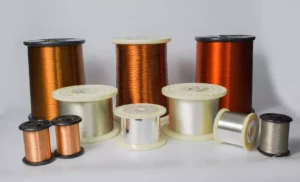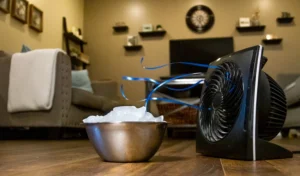Stale air and lingering odors making your space uncomfortable?
Choosing the wrong fan won’t solve the problem and can be a waste of money.
But what’s the right choice?
An exhaust fan removes stale air from a specific area, like a kitchen, by pushing it directly outside.
An inline fan, also called a duct fan, is installed within ductwork to move air through a larger system, circulating it throughout a building.
Understanding the key differences is crucial for effective ventilation.
This guide will break down everything from functionality to installation, helping you select the perfect fan for your needs and ensure a fresh, healthy environment.
What Is An Exhaust Fan?
Struggling with foggy mirrors and persistent kitchen smells?
These issues often point to poor air removal.
Without a proper solution, moisture can lead to mold and damage your home.
An exhaust fan is a ventilation device that pulls stale, humid, or polluted air from a room and expels it outdoors.
Typically installed in walls or ceilings, it is essential for areas like bathrooms and kitchens to maintain indoor air quality.
An exhaust fan is your go-to solution for targeted air removal in specific areas of your home or workplace.
Its primary job is to improve indoor air quality by getting rid of unwanted airborne particles like smoke, steam, grease, and odors.
By effectively removing excess moisture, these fans also play a critical role in preventing the growth of mold and mildew, which can pose health risks and cause structural damage over time.
Think of them as the frontline defense for rooms that are constantly exposed to humidity and pollutants.
How Exhaust Fans Work
The mechanics of an exhaust fan are straightforward but highly effective.
The fan consists of a motor, blades, and a housing unit.
When you switch it on, the motor powers the blades, causing them to spin rapidly.
This spinning motion creates suction, or negative pressure, which draws the surrounding air from the room into the fan’s housing.
From there, the captured air is pushed through a duct or vent and expelled outside the building.
This one-way airflow process ensures that stale air is continuously removed, allowing fresher air to enter the space naturally through windows, doors, or other openings.
The housing is typically mounted directly on a ceiling or wall, making it a visible fixture in the room.
Common Applications
- Bathrooms: In bathrooms, they are essential for removing steam and moisture generated from showers and baths. This helps prevent the buildup of condensation, protecting walls and paint from dampness and stopping mold growth.
- Kitchens: Kitchen exhaust fans, often found in range hoods or chimneys, are crucial for capturing and expelling cooking fumes, smoke, grease, and odors. This keeps the kitchen environment cleaner and more pleasant.
- Workshops and Garages: In spaces like workshops or garages, these fans remove harmful fumes from chemicals, paint, or vehicle exhaust, as well as dust particles from woodworking or other projects.
- Laundry Rooms: They are also used in laundry rooms to vent excess heat and humidity from dryers, which helps to control moisture levels in the home.
What Is An Inline Fan?
Is the air in some rooms always stuffy, even with the HVAC running?
Weak airflow in your ventilation system can make your entire space feel uncomfortable.
This often happens in systems with long or complex ductwork.
An inline fan, also known as a duct fan, is installed directly within a building’s ductwork to boost airflow.
Unlike exhaust fans, it works as part of a larger HVAC system to help distribute air evenly and maintain consistent temperature and circulation.
An inline fan is the hidden workhorse of a ventilation system.
Because it sits inside the ductwork, it is often out of sight, working quietly to ensure air gets where it needs to go.
Its main purpose is to overcome static pressure, which is the resistance to airflow caused by long duct runs, bends, and fittings.
By giving the air an extra push, an inline fan helps your main HVAC system operate more efficiently, ensuring that conditioned air reaches every corner of the building.
This makes it an essential component for achieving balanced air distribution, temperature control, and overall indoor air quality in both residential and commercial settings.
How Inline Fans Work
An inline fan operates by maintaining consistent momentum within the ductwork.
It consists of a cylindrical housing that contains a motor and fan blades, designed to fit seamlessly between two sections of duct.
As air travels through the ducts from the central HVAC unit, it can lose speed and pressure.
The inline fan’s blades spin to propel the air forward, effectively boosting it along its path.
This combination of axial flow and centrifugal effects allows it to move air efficiently through the system.
It can be used for both supply air, pushing conditioned air to rooms, and return air, pulling stale air back to the HVAC unit.
Common Applications
Thanks to their versatility, inline fans are used in a wide range of applications where airflow needs a boost.
Some of the most common uses include:
- HVAC Systems: They are frequently used in residential and commercial HVAC systems to improve the delivery of heated or cooled air to rooms that are far from the main unit.
- Grow Rooms and Greenhouses: Inline fans are ideal for controlling the environment in grow rooms by expelling excess heat and humidity and ensuring even air distribution, which is crucial for healthy plant growth.
- Server Rooms: In data centers and server closets, these fans help cool electronic equipment by venting hot air and improving circulation, preventing overheating.
- Bathroom and Kitchen Venting: While a standard exhaust fan can be used, an inline fan can be installed further up the duct line. This makes the system much quieter in the room itself, as the fan motor is located away from the living space, often in an attic or crawlspace.
Key Differences: Functionality and Placement
Choosing the wrong fan means you’re either pulling air from a single room or trying to boost a whole system with a tool not built for the job.
This mistake can lead to poor air quality and wasted energy.
The primary difference lies in their function: exhaust fans remove polluted air from a specific area directly to the outside.
In contrast, inline (duct) fans are designed to move and circulate air within a ductwork system, often covering a much larger area.
The distinction between these two fan types starts with their core purpose.
An exhaust fan is a specialist, designed for extraction.
Its job is to target and remove concentrated pockets of stale, humid, or contaminated air from a single location, such as a steamy bathroom or a smoky kitchen.
It acts as a point-of-source solution.
On the other hand, an inline fan is a system enhancer.
It doesn’t typically work alone but as part of a building’s broader ductwork network.
Its function is to boost, balance, and circulate air throughout that entire network, ensuring that conditioned air distributed by an HVAC system reaches all intended spaces efficiently.
Functional Roles
| Feature | Exhaust Fan | Inline (Duct) Fan |
| Primary Goal | Remove localized pollutants/moisture. | Boost airflow in a duct system. |
| Air Movement | Moves air from inside a room to the outside. | Moves air along the path of existing ductwork. |
| Scope of Impact | Affects a single, specific area or room. | Impacts multiple rooms or an entire building zone. |
| System Type | A standalone device for extraction. | A component within a larger HVAC system. |
Placement and Installation
The physical location where these fans are installed further highlights their differences.
- Exhaust Fans: These are installed at the point of use. You will typically find them mounted on a wall or ceiling within the room they are servicing, like a bathroom or kitchen. This placement allows them to immediately capture and expel contaminants. Installation requires creating an opening to the exterior of the building for a vent or duct.
- Inline Fans: As their name suggests, these fans are installed “in-line” within the ductwork itself. They are hidden from view, often located in attics, basements, or ceiling cavities. This placement offers flexibility, as they can be positioned at strategic points in the duct system to provide the most effective airflow boost. Installation involves accessing the ductwork and fitting the fan’s housing into a section of the duct.
Airflow, Noise, and Efficiency
An inefficient fan can struggle to move air, creating more noise than results.
This not only fails to solve your ventilation problem but also drives up your energy bill.
A loud fan can also be a constant disturbance.
Exhaust fans create negative pressure to pull air out of a room, while inline fans work by maintaining pressure to push air through ducts.
While inline fans are generally quieter because they are hidden in ductwork, modern exhaust fans offer energy-efficient motors and features to reduce both noise and energy use.
The way these fans move air is fundamentally different, which directly impacts their performance, sound levels, and energy consumption.
An exhaust fan’s job is to create a pressure difference, actively sucking air out of a room and forcing it outside.
This process of creating negative pressure is great for spot removal.
An inline fan, however, doesn’t need to create a large pressure differential from scratch.
Instead, it works with the existing airflow in a duct system, acting as a booster to overcome resistance and keep the air moving smoothly.
This distinction in their airflow mechanism is a key factor in why their noise profiles and efficiency ratings can vary significantly.
Airflow Mechanism
- Exhaust Fans: Operate by generating negative pressure in a localized area. This suction pulls air, along with moisture, odors, and pollutants, out of the space. The expelled air is then replaced by fresh air that enters the room from other parts of the building or from outside. This creates a simple, one-way exit path for unwanted air.
- Inline Fans: Work by overcoming static pressure and friction losses within the ductwork. They add momentum to the air that is already flowing, ensuring it reaches its destination effectively. This allows them to maintain optimal airflow over long distances and through complex duct layouts, supporting the overall efficiency of the ventilation system.
Noise Levels
- Exhaust Fans: The noise produced by an exhaust fan can vary widely depending on its size, power, and build quality. Since they are located directly in the living space, noise can be a significant concern, especially in residential settings like bedrooms or bathrooms. However, many modern models are designed to operate quietly.
- Inline Fans: Because they are installed inside ductwork and often located in unoccupied spaces like attics, inline fans are generally less noticeable. The ductwork itself can help muffle the sound. However, improper sizing or installation can cause vibrations that travel through the ducts, creating noise in living areas.
Energy Efficiency
- Exhaust Fans: Many modern exhaust fans are designed with energy efficiency in mind. They may feature energy-efficient motors, adjustable speed settings, and sensors (like humidity sensors) that allow the fan to operate only when needed. These features help reduce energy consumption and lower operating costs.
- Inline Fans: Energy-efficient models are also widely available for inline fans. Many use electronically commutated motors (ECMs), which offer variable speed control and are significantly more efficient than older motor types. This allows them to deliver powerful airflow while consuming minimal energy.
Conclusion
In short, exhaust fans are for removing bad air from one room.
Inline fans are for moving air through a whole system.
Choosing the right one improves air quality and saves energy.
Frequently Asked Questions
Can I use an exhaust fan as an intake fan?
While some fans can be reversed, exhaust fans are designed for one-way airflow to push air out.
Using one for intake would be inefficient and likely ineffective.
Which fan is quieter?
Inline fans tend to be quieter because they are located inside ductwork, away from living spaces, which muffles the noise.
Do I need a professional to install these fans?
Exhaust fan installation can be a DIY project, but inline fan installation is more complex as it involves modifying ductwork and is often best left to a professional.
Can an inline fan be used for a bathroom?
Yes, an inline fan is an excellent, quiet option for bathroom ventilation.
The fan is placed in the attic or crawlspace, connected by a duct to a vent in the bathroom ceiling.
Which fan moves more air?
Generally, inline fans are more powerful and designed to move larger volumes of air (measured in CFM) over greater distances compared to standard exhaust fans.
Do exhaust fans bring in fresh air?
No, exhaust fans only remove stale air from a room.
Fresh air enters the space passively through other openings like doors or windows to replace the air that was removed.
Why are exhaust fans mounted near the ceiling?
They are mounted high up because warm air, moisture, and odors naturally rise.
This placement allows the fan to capture and remove them more effectively.
Is an inline fan the same as a booster fan?
While both are installed in ducts, inline fans are typically more powerful and are designed as primary movers of air.
Booster fans are generally less powerful and are used to give a “boost” to weak airflow at the end of a long duct run.







